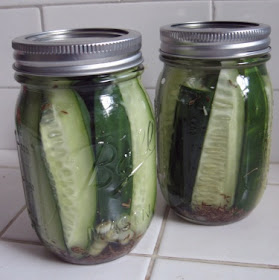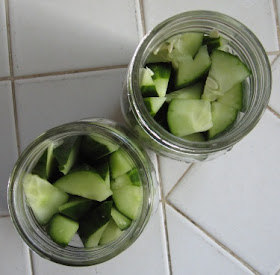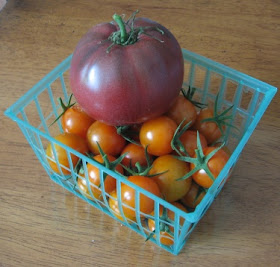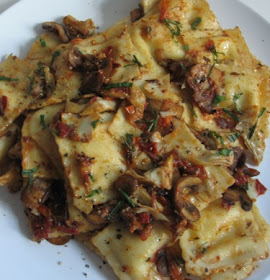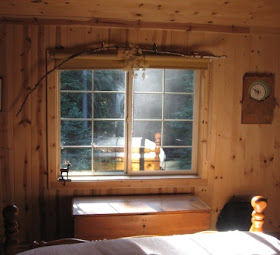
So for our birthdays this year John and I rented a car and escaped from blindingly sunny California to green, wet, and cool Oregon. It's always kind of surreal to have our chilly midwestern heritage birthdays supplanted by what passes for early fall in NorCal--that is to say, more summer. It never feels like my birthday here. So escaping to a place where jackets might feasibly be required seemed like an excellent plan.
We started off the road trip with lunch in Davis, home of roughly one million bicyclists. We went to
Delta of Venus, a very hippie-student-relaxing coffeehouse in an old run-down Victorian, and had pesto, cheese, and red onion sandwiches with big cups of fortifying coffee. Everything appeared almost instantly and was delicious. Afterward we wandered through downtown to buy honey at the Davis Food Co-op, which was large and clearly excellent. I totally want to spend more time in Davis in the future.
We spent our first night out in Weed, where I ate possibly both the biggest and meatiest sandwich of my life at the
Hi-Lo Cafe. This thing was terrifying: roast beef, bacon, and onion (or onion rings? I think it may have had onion rings) on a giant bun with a pile of fries and a big cup of jus for dipping of all kinds. There may have been pickles as well. It was truly massive and deeply satisfying, if also grounds for my arteries to immediately close up shop and declare a a strike.
For about half the trip, we rented a little cabin in the middle of nowhere outside Bend. Evidently Bend is the closest jumpoff for skiing at Mt. Bachelor, which means there are a million rentals available. It also means that early October is off-season, so we could pretty much take our pick of places.
So for a good chunk of a week this was my view.
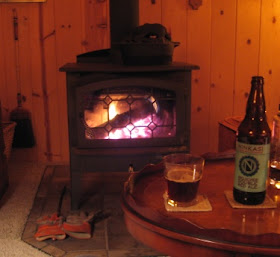
NICE. I kind of want a woodstove now (not that we need it even a little bit in our current house). That black iron thing on top of the stove is a humidifier, incidentally. You pour in water and it steams off as the fire burns. And it is totally necessary, since woodstove heat is extremely dessicating.
You will also notice the excellent craft beer I was drinking. Yay, beer! I don't think I can make a list of all the different Oregon beers we tried--we just went to the store and picked out individual bottles of everything that looked interesting. However, I can say that every single one of them was great. When we came back home, we went to see which ones we could find locally, and I'm happy to say that the
Ninkasi in the picture made the cut. Beer!
On my birthday we went for cocktails at a downtown Bend bar called
Velvet (watch out: sound).

Let me just say that had we been staying within walking distance, we would've spent quite a bit more time here. I got the Figlet, which is made of fresh figs (or maybe semi-dried, at least in October), pear puree, and vodka, and nicely made up for missing a week of farmer's market figs at home. John got the Stimulus, which is Bulleit, ginger beer, and lemonade, and which was also very good.
The birthday dinner we went out for afterward was kind of appalling, but let's just draw a veil over that unfortunate incident.
Ahem. Anyway, though we ate and drank at a few other places in Bend (
Common Table: excellent vegetarian food;
Thump Coffee: excellent coffee;
Deschutes Brewery: excellent beer), we spent most of the week cooking in the cabin itself.
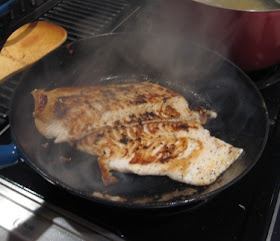
The kitchen was stocked with Le Creuset pans.
Wait, what?? But there they were. This was a prime reason to cook me a salted and peppered filet of fish one day. Just look at that sear! It's better than anything I could do at home. I didn't believe Le Creuset pans could actually be worth it, but I may now be changing my mind. Maybe I'll at least get a starter cast iron dude, if nothing else.
On the way out of Bend we ate breakfast at the excellent, friendly, and amusingly named
The Breakfast Club. What did I eat? I can't remember. Probably an omelet with lots of vegetables. I know there were definitely some hash browns and coffee, though. It's interesting to see how the hash brown style changed as we went north--all the far northern California and south central Oregon diners used a wide grate on the potato, which I haven't seen before. Yay regional food!
Next we headed through the deep green mist of Mt. Hood National Forest to Portland, land of copious books and great food. This is the point in the trip at which I totally stopped taking pictures, but that's ok! We ate yet another diner meal at a tiny place called
John's Coffee Shop, where 90% of the main room was filled with a counter and stools, the people working were Super nice, the menu was classic diner, and the prices were astoundingly cheap, especially coming from SV. Would Eat Again. Then we spent exorbitant amounts of time in Powells and drank lots of coffee before running off to NE Portland for dinner and beer with friends at
The Bye and Bye.
Ok, so you know how most bar food consists of, like, food-service chicken wings, overpriced burgers and fries, or faux-British bangers and mash? Yeah, that was not the case here at all. I had the barbecue brussels bowl: brown rice, brussels sprouts, tofu, and a shockingly good barbecue sauce. I now really, really need to replicate this in my own kitchen. I have the brussels sprouts ready and waiting; now all I really need to do is make up a batch of
our standard barbecue sauce and give it a try.
By this point we were getting pretty exhausted, so we made the call to head back south, eating merrily at as many diners as possible along the way. We stopped in Corvallis at
The Broken Yolk. I got a "skillet," which I expected to be a scramble, but which turned out not to be a scramble at all! Instead, it had scrambled eggs on one side of the plate and a big bowl of red pepper, spinach, feta, potatoes, artichoke hearts, and kalamata olives on the other. Don't get me wrong; it was still great. A big bowl of vegetables was certainly welcome, even if it was a surprise.
On the last day of the trip, we had breakfast at the
Black Bear Diner in Yreka, where even the "a little less breakfast" section of the menu provided a ham and cheese omelet so big I couldn't finish it, plus a buttermilk biscuit as big as my two fists. (Note to self: this is now the last time you've had ham! I have no idea how long it had been before this, however. I almost never eat ham.) Then we drove hell for leather through the entirety of northern California, through the worst rain I have ever seen in-state, and finally home to our own bed.
So, to sum up:
- Oregon is awesome.
- We were both glad to have our birthdays somewhere cool and nice and green.
- Oregon craft beer is a great idea.
- I enjoy coffee.
- I think our diner quota is now fulfilled until at least the end of the year.
Hooray vacation!
 This instance of peanut somen included a diced yellow carrot, a big pile of shredded green cabbage, a bunch of powdered ginger (though fresh would be far superior), and a not even remotely authentic poblano pepper.
This instance of peanut somen included a diced yellow carrot, a big pile of shredded green cabbage, a bunch of powdered ginger (though fresh would be far superior), and a not even remotely authentic poblano pepper. We used about a third of a large head of cabbage. It was not enough. More cabbage! MORE!
We used about a third of a large head of cabbage. It was not enough. More cabbage! MORE! When everything is cooked through, correct any seasonings. I like to add more sambal at the end, since earlier additions become sweet with cooking.
When everything is cooked through, correct any seasonings. I like to add more sambal at the end, since earlier additions become sweet with cooking.
